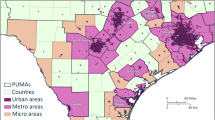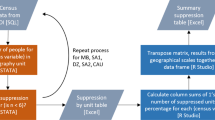Abstract
This paper addresses differences in survey response across city size by applying an explanation from House and Wolf to areas within cities. The data are from Toronto, Hamilton and Kitchener, in Canada. Consistent with other literature, response falls sharply from largest to smallest place, but variation in response rates within the cities is negligible. The intra-city analysis is accomplished by factor analyzing variables such as population density, crime rate and ethnic structure, mostly computed for census tracts, into a variable labelled social disorganization. What House and Wolf termed “compositional” variation in response is handled by record linking with municipal assessment information. The analysis is based on micro data taking the people listed for the sample as unit of observation.
Similar content being viewed by others
References
Benson, S., Booman, W.P., and Clark, K.E. (1951). A study of interview refusals. Journal of Applied Psychology 35: 116–19.
Breton, R. (1964) Institutional completeness of ethnic communities and the personal relations of immigrants. American Journal of Sociology 70: 193–205.
Champion, D.J. and Sear, A.M. (1969) Questionnaire response rate: a methodological analysis. Social Forces 47: 335–9.
DeMaio, T. (1980) Refusals: who, where, and why. Public Opinion Quarterly 44: 223–33.
Dunkelberg, W.C. and Day, G.S. (1973) Nonresponse bias and callbacks in sample surveys. Journal of Marketing Research 10: 160–8.
Fitzgerald, R. and Fuller, L. (1982) I hear you knocking but you can't come in: the effects of reluctant respondents and refusers on sample survey estimates. Sociological Methods and Research 11: 3–32.
Goudy, W.J. (1976) Nonresponse effects on relationships between variables, Public Opinion Quarterly 40: 360–9.
Goyder, J. (1987) The Silent Minority: Nonrespondents on Sample Surveys, Boulder, Colorado: Westview Press.
Hauser, R.M. (1974) Contextual effects revisited. Sociological Methods and Research 2: 365–375.
Hawkins, D.F. (1975) Estimation of nonresponse bias. Sociological Methods and Research 3: 461–88.
House, J.S. and Wolf, S. (1978) Effects of urban residence on interpersonal trust and helping behavior. Journal of Personality and Social Psychology 36: 1029–43.
Hunter, A. (1971) The ecology of Chicago: persistence and change, 1930–1960. American Journal of Sociology 77: 425–444.
Jones, Charles, Marsden, L., and Tepperman, L. (1990) Lives of Their Own: The Individualization of Women's Lives. Toronto: Oxford University Press.
O'Neil, M.J. (1979) Estimating the nonresponse bias due to refusals in telephone surveys. Public Opinion Quarterly 43: 218–32.
Reitz, Jeffrey G. (1980) The Survial of Ethnic Groups. Toronto: McGraw-Hill Ryerson.
Rosenthal, Robert and Rosnow, Ralph L. (1975) The Volunteer Subject, New York: Wiley.
Sampson, Robert J. and Groves, W. Byron (1989) Community and crime: testing social-disorganization theory. American Journal of Sociology 94: 774–802.
SAS (1986) SUGI Supplemental Library User's Guide, Version 5 Edition, Cary, North Carolina: SAS Institute.
Sjoberg, G. (1954) A Questionnaire on questionnaires. Public Opinion Quarterly 18: 423–24.
Smith, T.W. (1983) The hidden 25%: An analysis of nonresponse on the 1980 General Social Survey. Public Opinion Quarterly 47: 386–404.
Statistics Canada (1983) 1981 Census of Canada. Catalogue 95–952, 956, 977. Ottawa: Minister of Supply and Services.
Statistics Canada (1987) 1986 Census of Canada. Ontario, Cat. 92–114. Ottawa: Ministry and Supply and Services.
Steeh, C.G. (1981) Trends in nonresponse rates, 1952–1979. Public Opinion Quarterly 45: 40–57.
Tucker, C. (1983) Interviewer effects in telephone surveys. Public Opinion Quarterly 47: 84–95.
Weaver, C.N., Holmes, S.L., and Glenn, N.D. (1975). Some characteristics of inaccessible respondents in a telephone survey. Journal of Applied Psychology 60: 260–2.
Author information
Authors and Affiliations
Rights and permissions
About this article
Cite this article
Goyder, J., Lock, J. & McNair, T. Urbanization effects on survey nonresponse: a test within and across cities. Qual Quant 26, 39–48 (1992). https://doi.org/10.1007/BF00177996
Issue Date:
DOI: https://doi.org/10.1007/BF00177996




